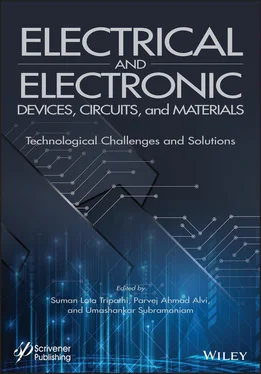The chapter is organized as follows: Section 4.1is an introduction to tunable filter. Section 4.2describes the literature review in this area. Section 4.3discusses our designed filter with fractal DGS for size reduction and tunable filter with the use of varactor diodes. Section 4.4is the conclusion.
Research in the microwave tunable filter can be classified into two major categories. First, to reduce effects on the performance parameter of the tunable filter like insertion loss, selectivity and linearity deterioration. Second, to attain better levels of tuning in terms of centre frequency tuning, bandwidth tuning and filtering type (e.g., switching between bandpass/ bandstop responses) [8].
As per reported literature, a tunable microwave filter can have mechanical tunning, magnetic tunning and electronic tunning. Mechanically tunable filters are designed using the coaxial cavity or waveguide resonators. Mechanical tuning is achieved by moving a tuning screw or plate to change the resonant frequency of a tunable filter. They can handle large power and they have low insertion loss. Mechanical tuned filters are large and bulky, and having slow tuning makes them unsuitable for current communication systems [9–11]. Magnetically tunable filters are popular in microwave communication systems due to the high quality factor, wide tunning range and low insertion loss. They use single crystal Yttrium-Iron-Garnet (YIG) spheres in the resonators and it can be tuned by altering the biasing current. Magnetically tunable filters offer low insertion loss but they are larger in size, consume more power and offer slow tuning speed [12, 13].
Electronically tunable filters incorporate variable capacitors, semiconductor diodes or RF MEMS switches, which are biased with DC voltage. The applied DC voltage changes capacitance or inductance loading in a resonator, which tunes the centre frequency of the filter. Electrically filters are more popular due to their better tuning range, miniaturization, speed of tuning and suitability to integrate with latest communication hardware [14–16]. The proposed work is based on planar structure, hence, the literature review related to it is presented.
4.2.1 Planar Reconfigurable Filters
Planar structure provides a simple structure and allows flexible filter design, and it is easy to integrate tuning with it. Cho, Y. H. et al . [17] proposed reconfigurable filter, which changes from bandpass to bandstop by changing the coupling coefficient of resonators controlled by RF MEMS switches and varactors. Bouyge D. A. et al . [18] proposed size reduction using split ring resonators (SRR) and frequency agility using vanadium dioxide switches. Different combination of switches adds a pole to the bandstop filter to change configurations of bandwidth and centre frequency. Bandwidth or center frequency switching is also possible with P-I-N diodes. Miller A. et al . [19] designed tunable bandpass filters with switchable bandwidths using short circuit coupled lines and short circuit stubs with P-I-N diodes. When the P-I-N diodes are in the ON mode, it achieves around 35% fractional bandwidth (FBW), while in OFF mode FBW is reduced to 16%, at a centre frequency of 1.9 GHz.
High-temperature superconducting (HTS) filters are popular due to their low insertion loss and they can be easily realized with higher orders. A HTS-based tunable bandpass filter with dual-mode resonator and Gallium arsenide (GaAs) varactors was proposed in [20]. The said work is designed for L-band tuning range from 0.784 GHz to 0.918 GHz (16%) while having small variation in fractional bandwidth. Hu Jiang et al . [21] proposed quasi-elliptic coplanar waveguide (CPW) tunable bandpass filter using BST varctors in Ka band. The filter exhibits area reduced by 35% with constant fraction bandwidth (FBW).
Filter size miniaturization is a demand in modern communication systems. Surface Integrated Waveguide (SIW) structure has low losses, higher Q value and is easy to integrate with other planar technologies. Bin You et al . [22] proposed tunable filter based on Half-mode SIW (HMSIW). HMSIW has the advantages of SIW along with size reduction to 50%. Bin You et al . [22] utilized reduced space to load JDV2S71E varactor (manufactured by TOSHIBA) as a tuning element. Designed HMSIW filter provides both center frequency and bandwidth tuning capabilities.
Filter size can be reduced in different ways in microwave circuit design. One of them is by using metamaterial. A metamaterial-based tunable is proposed in [23] for size reduction and ease in integration for FM receivers. A dumbbell-shaped slot metamaterial along with varactor diode is used to change center frequency from 9.1 GHz to 11 GHz. Another way to reduce the size of the filter is to use Defected Ground Structure (DGS) with fractal geometry. Research activity has increased to use DGS in planar filters as it offers better performance and compactness. If a higher iteration level of fractal DGS is utilized, the bandpass filter becomes more compact [24].
The next section proposes a tunable bandpass filter utilizing hairpin structure along with fractal DGS for size reduction. Tuning is proposed by varactor diodes used in the geometry of fractal DGS.
Here, initial design of hairpin bandpass filter having a center frequency of 3.5 GHz with bandwidth 430 MHz is proposed. Fractal DGS (3 rditeration of hexagonal shape) is introduced into it, so that its dimension can be reduced. After fractal DGS, varactor diode (variable capacitor) is inserted and thus, by changing the capacitance the center frequency of the band can be changed.
4.3.1 Design of Hairpin Bandpass Filter
A hairpin filter is a popular bandpass filter in microstrip filter theory. The hairpin bandpass structure is compact in size. They can be derived by folding the resonators (λ/2 length) of parallel coupled lines, into a “U” shape. This folded resonator is named as a hairpin resonator [25]. A 3 rdorder bandpass filter centred at 3.5 GHz with 430 MHz Bandwidth (FBW=12.28%) has been selected. Substrate is chosen as RO3010 (ɛ r=10.2) with thickness 1.27 mm. Design formula for hairpin filter can be used from [25, 26]. Also, design parameters can be extracted from facility available in CST MICROWAVE STUDIO ®V. 2018 by providing requirements of the filter. The design parameters for the hairpin bandpass filter are as shown in Table 4.1. We have chosen to have a 3 rdorder filter to have less complexity and reduction in size. Designed filter with specific dimensions is shown in Figure 4.2.
The simulated results of S 21and S 11of the designed hairpin bandpass filters are shown in Figure 4.3. The graph is plotted between gain (in dB) versus frequency (in GHz). S 21shows the passband of the filter and it is observed that the passband of the filters has center frequency 3.48 GHz and 430 MHz 3-dB bandwidth. Filter response also shows good out of band rejection. S 11shows the return loss of the filter. The filter is resonating exactly at 3.5 GHz frequency and has return loss of 28 dB, which is quite good.
Table 4.1Design specification of proposed hairpin bandpass filter.
| Design specifications |
| Band Pass Centre Frequency |
3.5 GHz |
| Substrate (Ɛr) |
10.2 |
| Substrate Thickness |
1.27 mm |
| Bandwidth |
430 MHz |
| Insertion loss |
<1 dB |
| Return loss |
< -20 dB |

Figure 4.2 Layout of the hairpin bandpass filter.
Читать дальше













